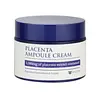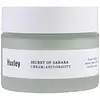What's inside
What's inside
 Key Ingredients
Key Ingredients

 Benefits
Benefits

 Concerns
Concerns

 Ingredients Side-by-side
Ingredients Side-by-side

Water
Skin ConditioningHydrogenated Olive Oil Lauryl Esters
Emulsion StabilisingNeopentyl Glycol Diheptanoate
EmollientDipropylene Glycol
HumectantPlacental Protein
HumectantHydrogenated Poly(C6-14 Olefin)
EmollientNiacinamide
SmoothingGlycerin
HumectantButylene Glycol
HumectantGlyceryl Stearate
EmollientPEG-100 Stearate
Cetearyl Alcohol
EmollientCetearyl Glucoside
EmulsifyingStearic Acid
CleansingCyclomethicone
EmollientCaprylyl Glycol
EmollientDimethicone
EmollientAmmonium Acryloyldimethyltaurate/Vp Copolymer
Cyclopentasiloxane
EmollientTrehalose
HumectantSodium Hyaluronate
HumectantAdenosine
Skin ConditioningAllantoin
Skin ConditioningBeta-Glucan
Skin ConditioningPropylene Glycol
HumectantHydrolyzed Extensin
Skin ConditioningRubus Idaeus Fruit Extract
AstringentArnica Montana Flower Extract
MaskingArtemisia Absinthium Extract
Skin ConditioningAchillea Millefolium Extract
CleansingGentiana Lutea Root Extract
Skin ConditioningAlcohol
AntimicrobialRosa Hybrid Flower Extract
Skin ConditioningPortulaca Oleracea Extract
Skin ConditioningBetula Platyphylla Japonica Juice
Skin ConditioningLavandula Angustifolia Oil
MaskingDisodium EDTA
Water, Hydrogenated Olive Oil Lauryl Esters, Neopentyl Glycol Diheptanoate, Dipropylene Glycol, Placental Protein, Hydrogenated Poly(C6-14 Olefin), Niacinamide, Glycerin, Butylene Glycol, Glyceryl Stearate, PEG-100 Stearate, Cetearyl Alcohol, Cetearyl Glucoside, Stearic Acid, Cyclomethicone, Caprylyl Glycol, Dimethicone, Ammonium Acryloyldimethyltaurate/Vp Copolymer, Cyclopentasiloxane, Trehalose, Sodium Hyaluronate, Adenosine, Allantoin, Beta-Glucan, Propylene Glycol, Hydrolyzed Extensin, Rubus Idaeus Fruit Extract, Arnica Montana Flower Extract, Artemisia Absinthium Extract, Achillea Millefolium Extract, Gentiana Lutea Root Extract, Alcohol, Rosa Hybrid Flower Extract, Portulaca Oleracea Extract, Betula Platyphylla Japonica Juice, Lavandula Angustifolia Oil, Disodium EDTA
Opuntia Ficus-Indica Stem Extract
Skin ConditioningGlycerin
HumectantHydrogenated Olive Oil Lauryl Esters
Emulsion StabilisingSqualene
EmollientButylene Glycol
HumectantDimethicone
EmollientPentaerythrityl Tetraethylhexanoate
EmollientDiisostearyl Malate
EmollientButyrospermum Parkii Butter
Skin ConditioningJojoba Esters
EmollientWater
Skin ConditioningBehenyl Alcohol
EmollientGlyceryl Stearate
Emollient1,2-Hexanediol
Skin ConditioningAdenosine
Skin ConditioningOpuntia Ficus-Indica Seed Oil
EmollientPerilla Ocymoides Leaf Extract
TonicPaeonia Suffruticosa Root Extract
Skin ProtectingSalvia Officinalis Leaf Extract
CleansingCarthamus Tinctorius Flower Extract
Skin ConditioningGardenia Florida Fruit Extract
Skin ConditioningBetula Platyphylla Japonica Juice
Skin ConditioningSodium Hyaluronate
HumectantBeta-Glucan
Skin ConditioningCyclopentasiloxane
EmollientTrimethylsiloxysilicate
EmollientCetearyl Alcohol
EmollientPEG-100 Stearate
Cetyl Alcohol
EmollientStearyl Alcohol
EmollientCetearyl Glucoside
EmulsifyingHydroxyethyl Acrylate/Sodium Acryloyldimethyl Taurate Copolymer
Emulsion StabilisingPropanediol
SolventCarbomer
Emulsion StabilisingEthylhexylglycerin
Skin ConditioningPolyglyceryl-10 Pentastearate
Skin ConditioningAlcohol
AntimicrobialCaprylic/Capric Triglyceride
MaskingDextrin
AbsorbentSodium Stearoyl Lactylate
EmulsifyingHydrogenated Lecithin
EmulsifyingCaprylyl Glycol
EmollientGlyceryl Caprylate
EmollientTromethamine
BufferingDisodium EDTA
Phenoxyethanol
PreservativeParfum
MaskingOpuntia Ficus-Indica Stem Extract, Glycerin, Hydrogenated Olive Oil Lauryl Esters, Squalene, Butylene Glycol, Dimethicone, Pentaerythrityl Tetraethylhexanoate, Diisostearyl Malate, Butyrospermum Parkii Butter, Jojoba Esters, Water, Behenyl Alcohol, Glyceryl Stearate, 1,2-Hexanediol, Adenosine, Opuntia Ficus-Indica Seed Oil, Perilla Ocymoides Leaf Extract, Paeonia Suffruticosa Root Extract, Salvia Officinalis Leaf Extract, Carthamus Tinctorius Flower Extract, Gardenia Florida Fruit Extract, Betula Platyphylla Japonica Juice, Sodium Hyaluronate, Beta-Glucan, Cyclopentasiloxane, Trimethylsiloxysilicate, Cetearyl Alcohol, PEG-100 Stearate, Cetyl Alcohol, Stearyl Alcohol, Cetearyl Glucoside, Hydroxyethyl Acrylate/Sodium Acryloyldimethyl Taurate Copolymer, Propanediol, Carbomer, Ethylhexylglycerin, Polyglyceryl-10 Pentastearate, Alcohol, Caprylic/Capric Triglyceride, Dextrin, Sodium Stearoyl Lactylate, Hydrogenated Lecithin, Caprylyl Glycol, Glyceryl Caprylate, Tromethamine, Disodium EDTA, Phenoxyethanol, Parfum
Ingredients Explained
These ingredients are found in both products.
Ingredients higher up in an ingredient list are typically present in a larger amount.
Adenosine is in every living organism. It is one of four components in nucleic acids that helps store our DNA.
Adenosine has many benefits when used. These benefits include hydrating the skin, smoothing skin, and reducing wrinkles. Once applied, adenosine increases collagen production. It also helps with improving firmness and tissue repair.
Studies have found adenosine may also help with wound healing.
In skincare products, Adenosine is usually derived from yeast.
Learn more about AdenosineAlcohol comes in many different forms. Different types of alcohol will have different effects on skin. This ingredient is usually an astringent alcohol.
These alcohols are drying on the skin. They may strip away your skin's natural oils and even damage your skin barrier. Astringent alcohols may also irritate skin.
Other types of astringent alcohols include:
According to the National Rosacea Society based in the US, you should be mindful of products with these alcohols in the top half of ingredients.
Any type of sanitizing product will have high amounts of alcohol to help kill bacteria and viruses.
Fatty alcohols come from plant oils such as coconut oil. These can help hydrate the skin and are non-irritating. Some fatty alcohols include cetyl and stearyl alcohol.
Learn more about AlcoholBeta-Glucan is a polysaccharide. It can be derived from the cell walls of seaweed, oats, yeast, and fungi. It hydrates the skin and helps boost your skin's natural barrier.
As an antioxidant, beta-glucan helps fight free-radicals. Free-radicals are molecules that may damage your skin cells, such as pollution.
Studies show this ingredient may be an effective wrinkle reducer as it can deeply penetrate into skin. It has also been show to help with wound healing.
Learn more about Beta-GlucanBetula Platyphylla Japonica Juice is the sap of the Asian White Birch tree. Birch juice has antioxidant, hydrating, and soothing properties.
The high content of amino acids, sugars, and minerals provide the skin with moisture. On top of that, it contains Vitamins C and B (niacinamide). These two superstar ingredients protect your skin while reducing dark spots.
This white birch is currently being studied for potential anti-cancer properties. It has been used in traditional Asian medicine to help treat infections.
Learn more about Betula Platyphylla Japonica JuiceButylene Glycol (or BG) is used within cosmetic products for a few different reasons:
Overall, Butylene Glycol is a safe and well-rounded ingredient that works well with other ingredients.
Though this ingredient works well with most skin types, some people with sensitive skin may experience a reaction such as allergic rashes, closed comedones, or itchiness.
Learn more about Butylene GlycolCaprylyl Glycol is a humectant and emollient, meaning it attracts and preserves moisture.
It is a common ingredient in many products, especially those designed to hydrate skin. The primary benefits are retaining moisture, skin softening, and promoting a healthy skin barrier.
Though Caprylyl Glycol is an alcohol derived from fatty acids, it is not the kind that can dry out skin.
This ingredient is also used as a preservative to extend the life of products. It has slight antimicrobial properties.
Learn more about Caprylyl GlycolCetearyl alcohol is a mixture of two fatty alcohols: cetyl alcohol and stearyl alcohol. It is mainly used as an emulsifier. Emulsifiers help prevent the separation of oils and products. Due to its composition, it can also be used to thicken a product or help create foam.
Cetearyl alcohol is an emollient. Emollients help soothe and hydrate the skin by trapping moisture.
Studies show Cetearyl alcohol is non-toxic and non-irritating. The FDA allows products labeled "alcohol-free" to have fatty alcohols.
This ingredient is usually derived from plant oils such as palm, vegetable, or coconut oils. There is debate on whether this ingredient will cause acne.
Due to the fatty acid base, this ingredient may not be Malassezia folliculitis safe.
Learn more about Cetearyl AlcoholCetearyl Glucoside is a surfactant and emulsifier. It can be produced from synthetic of natural sources of cetearyl alcohol and glucose.
Emulsifiers help prevent ingredients from separating, such as oils and waters. It can also be used to enhance the texture of products.
As a surfactant, Cetearyl Glucoside helps during the cleansing process. By gathering all the dirt and oils, it allows these molecules to be washed away easily.
Learn more about Cetearyl GlucosideCyclopentasiloxane, or D5, is a silicone used to improve texture of products and trap moisture.
D5 is considered lightweight and volatile. Volatile means it evaporates quickly after application. Once evaporated, D5 leaves a thin barrier that helps keep skin hydrated.
It is also an emollient. Emollients help soften the skin and prevent water loss. Silicones create a silky texture in products. D5 helps other ingredients become more spreadable.
Studies show D5 is safe to use in skincare products. We recommend speaking with a skincare professional if you have concerns.
Learn more about CyclopentasiloxaneDimethicone is a type of synthetic silicone created from natural materials such as quartz.
What it does:
Dimethicone comes in different viscosities:
Depending on the viscosity, dimethicone has different properties.
Ingredients lists don't always show which type is used, so we recommend reaching out to the brand if you have questions about the viscosity.
This ingredient is unlikely to cause irritation because it does not get absorbed into skin. However, people with silicone allergies should be careful about using this ingredient.
Note: Dimethicone may contribute to pilling. This is because it is not oil or water soluble, so pilling may occur when layered with products. When mixed with heavy oils in a formula, the outcome is also quite greasy.
Learn more about DimethiconeDisodium EDTA plays a role in making products more stable by aiding other preservatives.
It is a chelating agent, meaning it neutralizes metal ions that may be found in a product.
Disodium EDTA is a salt of edetic acid and is found to be safe in cosmetic ingredients.
Learn more about Disodium EDTAGlycerin is already naturally found in your skin. It helps moisturize and protect your skin.
A study from 2016 found glycerin to be more effective as a humectant than AHAs and hyaluronic acid.
As a humectant, it helps the skin stay hydrated by pulling moisture to your skin. The low molecular weight of glycerin allows it to pull moisture into the deeper layers of your skin.
Hydrated skin improves your skin barrier; Your skin barrier helps protect against irritants and bacteria.
Glycerin has also been found to have antimicrobial and antiviral properties. Due to these properties, glycerin is often used in wound and burn treatments.
In cosmetics, glycerin is usually derived from plants such as soybean or palm. However, it can also be sourced from animals, such as tallow or animal fat.
This ingredient is organic, colorless, odorless, and non-toxic.
Glycerin is the name for this ingredient in American English. British English uses Glycerol/Glycerine.
Learn more about GlycerinGlyceryl Stearate is a mix of glycerin and stearic acid.
It is used to stabilize the mixing of water and oil ingredients. By preventing these ingredients from separating, it can help elongate shelf life. It can also help thicken the product's texture.
As an emollient, it helps soften skin and supports barrier-replenishing ingredients.
In cosmetics, Glyceryl Stearate is often made from vegetable oils or synthetically produced.
This ingredient may not be fungal-acne safe
Fun fact: The human body also creates Glyceryl Stearate naturally.
Learn more about Glyceryl StearateHydrogenated Olive Oil Lauryl Esters is an oil and isn't fungal acne safe.
Peg-100 Stearate is an emollient and emulsifier. As an emollient, it helps keep skin soft by trapping moisture in. On the other hand, emulsifiers help prevent oil and water from separating in a product.
PEGS are a hydrophilic polyether compound . There are 100 ethylene oxide monomers in Peg-100 Stearate. Peg-100 Stearate is polyethylene glycol ester of stearic acid.
Sodium Hyaluronate is hyaluronic acid's salt form. It is commonly derived from the sodium salt of hyaluronic acid.
Like hyaluronic acid, it is great at holding water and acts as a humectant. This makes it a great skin hydrating ingredient.
Sodium Hyaluronate is naturally occurring in our bodies and is mostly found in eye fluid and joints.
These are some other common types of Hyaluronic Acid:
Learn more about Sodium HyaluronateWater. It's the most common cosmetic ingredient of all. You'll usually see it at the top of ingredient lists, meaning that it makes up the largest part of the product.
So why is it so popular? Water most often acts as a solvent - this means that it helps dissolve other ingredients into the formulation.
You'll also recognize water as that liquid we all need to stay alive. If you see this, drink a glass of water. Stay hydrated!
Learn more about Water